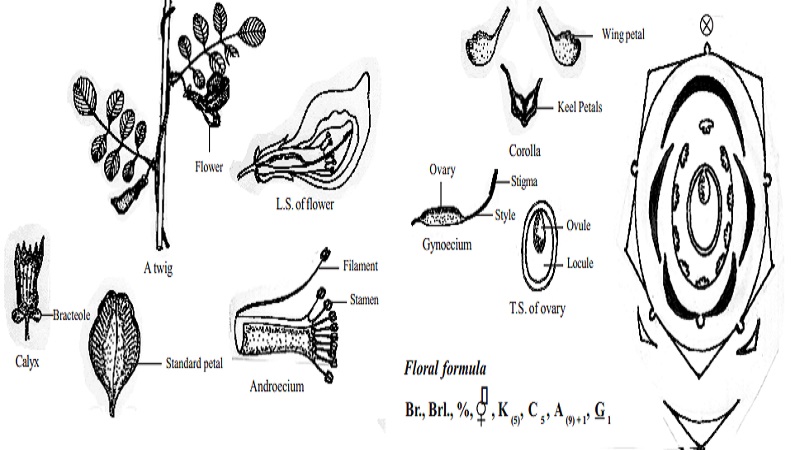Chapter: 11 th 12th std standard Bio Botany plant tree Biology Higher secondary school College Notes
Botanical description and Economical of Clitoria ternatea

Botanical description of Clitoria ternatea
Habit
Twining climber.
Root
Branched tap root system having nodules.
Stem
Aerial, weak stem and a twiner.
Leaf
Imparipinnately compound, alternate, stipulate showing reticulate venation. Leaflets are stipellate. Petiole and stipel are pulvinated.
Inflorescence
Axillary and solitary.
Flower
Bracteate, bracteolate, bracteoles usually large, pedicellate, dichlamydeous, complete, bisexual, pentamerous, zygomorphic and hypogynous.
Calyx
Sepals 5, green, gamosepalous showing valvate aestivation. Odd sepal is anterior in position.
Corolla
Petals 5, blue or white, polypetalous, irregular, papilionaceous corolla showing descendingly imbricate aestivation.
Androecium
Stamens 10, diadelphous (9)+1, nine stamens fused to form a bundle and the tenth stamen is free, posterior and opposite to the standard petal. Anthers are dithecous, basifixed, introrse and dehiscing by longitudinal slits.
Gynoecium
Ovary superior, stipitate and monocarpellary. Ovary unilocular with many ovules on marginal placentation. Style simple and incurved with feathery stigma.
Fruit
A legume.
Seed
Non-endospermous and kidney shaped.
Floral formula
Br., Brl., per, &+, K (5), C 5 , A (9) + 1, G 1
Economic importance
1. Pulses
The seeds of Cajanus cajan (red gram), Vigna mungo (black gram), Vigna radiata (green gram), Vigna ungiculata (horse gram) and Cicer arietinum (chick pea) are rich in proteins and used as pulses.
2. Vegetables
The tender fruits of Lablab purpureus (field bean) and leaves of
Sesbania grandiflora (agathi) are used as vegetables and greens.
3. Oil plants
Oil extracted from the seeds of Arachis hypogea (ground nut) is used for cooking. Seeds are edible. Pongam oil obtained from the seeds of Pongamia pinnata (pongam) has medicinal value and is used in the preparation of soap.
4. Timber plants
Timber is obtained from Dalbergia latifolia (rose wood) andPterocarpus santalinus (red sandal wood) is used for making furniture, cabinet articles and other building materials.
5. Fibre plants
Fibres obtained from Crotalaria juncea (sunhemp) and Sesbania aegyptiaca (sesban) are used for making ropes.
6. Dye plants
The important blue dye, indigo obtained from Indigofera tinctoria (Avuri) is used in the colouring of printing ink and paints. Blue dye is also obtained from the flowers and seeds of Clitoria ternatea.
7. Ornamental plants
Butea frondosa (flame of the forest), Clitoria ternatea, Lathyrus odoratus (sweet pea) and Lupinus hirsutus are grown as ornamental plants.
Related Topics